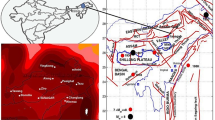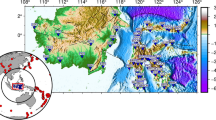Abstract
We computed the coda wave attenuation (QC) using reservoir-induced seismicity of the Koyna–Warna region in the western part of the Indian shield. We analyzed 484 local seismograms recorded by 16 broadband seismic stations at central frequencies 1.5, 3, 6, 12, and 24 Hz for lapse time window lengths 30s, 40s, 50s, and 60s using the single-backscattering method (Aki and Chouet 1975). The results show that spatial variation of QC, increases from west to east, and north to south in the study region. Our lapse time-dependent of QC estimates are (138.05±37.41)f(1.07±0.07), (191.18±45.24)f(1.00±0.07), (240.07±61.50)f(0.95±0.08), and (299.42±76.32)f(0.88±0.07) for 30s, 40s, 50s and 60s, respectively. The results show that low QC at low frequencies (<3 Hz), which indicates high attenuation at a shallow depth of the region. We compared QC with other regions of the world, as well as in India. Our results are high compared to the earlier studies in the Koyna–Warna region. The frequency-dependent parameter, η is greater than 1, which represents that the study region is seismically active. This study is important for evaluating the source parameters and seismic hazard assessment of the region.
Research Highlights
-
These are the first scientific Qc results obtained using educational seismographs installed in schools in the western part of India.
-
We have used 484 local earthquakes using 16 seismic stations in the Koyna-Warna region for this study.
-
The region shows low QC to the west of compared to east of WGE and it is high for east of Koyna reservoir.
-
The η values are high, varying between 0.76 and 1.19, which indicates the region is heterogeneous and seismically active.
-
The seismic quality factor, QC values are little high and they agree with previous studies in the region.




Similar content being viewed by others
References
Agrawal P K, Pandey O P and Chetty T R K 2004 Aeromagnetic anomalies lineaments and seismicity in Koyna–Warna region; J. Ind. Geop. Uni. 8 229–242.
Aki K 1980 Attenuation of shear waves in the lithosphere for frequencies from 0.05 to 25 Hz; Phys. Earth Planet. Int. 21 50–60.
Aki K 2003 Seismology of earthquake and volcanic prediction; In: Proceedings of the Seventh Workshop on Non-Linear Dynamics and Earthquake Prediction, The Abdus Salam International Centre for Theoretical Physics, Trieste, Italy, H4.SMR/1519-10.
Aki K and Chouet B 1975 Origin of coda waves: Source, attenuation and scattering effects; J. Geophys. Res. 80 3322–3342, https://doi.org/10.1029/JB080i023p03322.
Akinci A, Taktak A G and Ergintav S 1994 Attenuation of coda waves in Western Anatolia; Phys. Earth Planet. Int. 87 155–165.
Azguet R, Ghizlane B, Youssef T, Mimoun H and Younes E L F 2019 Attenuation of coda waves in the SW of High-Atlas area, Morocco; Geod. Geodyn. 10 297–306, https://doi.org/10.1016/j.geog.2019.05.001.
Biswas K, Kumar M and Mandal P 2016 Lapse time dependent coda-Q (Qc) in the Kachchh, rift zone, Gujarat, India; Nat. Hazards, https://doi.org/10.1007/s11069-016-2147-x.
Catchings R D, Dixit M M, Goldman M R and Kumar S 2015 Structure of the Koyna–Warna Seismic Zone, Maharashtra, India: A possible model for large induced earthquakes elsewhere; J. Geophys. Res. Solid Earth 120 3479–3506, https://doi.org/10.1002/2014JB011695.
Del Pezzo E, Ibanez J, Morales J, Akinci A and Maresca R 1995 Measurements of intrinsic and scattering seismic attenuation in the crust; Bull. Seismol. Soc. Am. 85 1373–1380.
Dev S M S P and Nagarajan R 2017 Seismic hazard assessment of Koyna region, peninsular India: Using geospatial approach; Geoenviron. Disasters 4 27, https://doi.org/10.1186/s40677-017-0092-y.
Dixit M M, Kumar S, Catchings R D, Suman K, Sarkar D and Sen M K 2014 Seismicity, faulting, and structure of the Koyna–Warna seismic region, Western India from local earthquake tomography and hypocenter locations; J. Geophys. Res. Solid Earth 119 6372–6398, https://doi.org/10.1002/2014JB010950.
Fard R A, Gholam J D, Mohsen F, Habib R and Majid M 2020 Coda wave attenuation's dependency on Lapse time and frequency in west of Iran plateau using local earthquakes; Ann. Geophys. 63(4) SE437, https://doi.org/10.4401/ag-8165.
Gupta H K 2019 Koyna, India: An ideal site for near field earthquake observations; Proc. Ind. Nat. Sci. Acad. 85(2) 469–480, https://doi.org/10.1007/S12594-017-0771-2.
Gupta S C, Singh V N and Ashwani K 1995 Attenuation of coda waves in the Garhwal Himalaya, India; Phys. Earth Planet. Int. 87 247–253.
Gupta S C, Teotia S S, Rai S S and Navneet G 1998 Coda Q estimates in the Koyna Region, India; Pure Appl. Geophys. 153 713–731.
Hasegawa H S 1985 Attenuation of Lg waves in the Canadian Shield; Bull. Seismol. Soc. Am. 75 1569–1582.
Havskov J, Malone S, McClurg D and Crosson R 1989 Coda Q for the State of Washington; Bull. Seismol. Soc. Am. 79 1024–1038.
Ibanez J M, Del Pezzo E, De Miguel F, Herraiz M, Alguacil G and Morales J 1990 Depth-dependent seismic attenuation in the Granada zone (Southern Spain); Bull. Seismol. Soc. Am. 80(5) 1232–1244.
Jens Havskov, Mathilde B Sørensen, Dina Vales, Mehmet Özyazıcıoğlu, Gerardo Sánchez and Bin Li 2016 Coda Q in different tectonic areas, influence of processing parameters; Bull. Seismol. Soc. Am. 106(3) 956–970, https://doi.org/10.1785/0120150359.
Kaila K L, Murthy P R K, Rao V K and Kharetchko G E 1981a Crustal structure from deep seismic sounding along the Koyna 11 (Kelsi–Loni) profile in Deccan trap area, India; Tectonophys. 73 365–384.
Kaila K L, Reddy P R, Dixit M M and Lazarenko M M 1981b Deep crustal structure at Koyna, Maharashtra indicated by deep seismic sounding; J. Geol. Soc. India 22 1–16.
Knopoff L and Hudson J A 1964 Transmission of love waves at a vertical discontinuity; J. Geophys. Res. 72 3969–3984.
Krishnan M S 1960 Geology of India and Burma; 4th edn, Higginbotham, Madras, 604p.
Kumar N, Parvez I A and Virk H S 2005 Estimation of coda wave attenuation for NW Himalayan region using local earthquakes; Phys. Earth Planet. Int. 151(3–4) 243–258, https://doi.org/10.1016/j.pepi.2005.03.010.
Mandal P and Rastogi B K 1998 A frequency-dependent relation of coda Qc for Koyna–Warna region, India; Pure Appl. Geophys. 153 163–177.
Mandal P, Jainendra S, Joshi S, Kumar S, Bhunia R and Rastogi B K 2004 Low coda QC in the epicentral region of the 2001 Bhuj earthquake of Mw 7.7; Pure Appl. Geophys. 161 1635–1654.
Mukhopadhyay S and Sharma J 2010 Attenuation characteristics of Garhwal–Kumaun Himalayas from analysis of coda of local earthquakes; J. Seismol. 14 693–713, https://doi.org/10.1007/s10950-010-9192-9.
Mukhopadhyay S and Tyagi C 2007 Lapse time and frequency-dependent attenuation characteristics of coda waves in the northwestern Himalayas; J. Seismol. 11 149–158, https://doi.org/10.1007/s10950-006-9042-y.
Padhy S and Subhadra N 2010 Attenuation of high-frequency seismic waves in northeast India; Geophys. J. Int. 181 453–467.
Padhy S, Subhadra N and Kayal J R 2011 Frequency-dependent attenuation of body and coda waves in the Andaman Sea Basin; Bull. Seismol. Soc. Am. 101(1) 109–125, https://doi.org/10.1785/0120100032.
Patro B P K and Sarma S V S 2007 Trap thickness and the subtrappean structures related to mode of eruption in the Deccan Plateau of India: Results from magnetotellurics; Earth Planet. Space 59 75–81.
Pujades L, Canas J A, Egozcue J J, Puigvi M A, Pous J, Gallart J, Lana X and Casas A 1991 Coda Q distribution in the Iberian Peninsula; Geophys. J. Int. 100 285–301.
Pulli J J 1984 Attenuation of coda waves in New England; Bull. Seismol. Soc. Am. 74 1149–1166.
Rai S S, Singh S K, Rajagopal Sarma P V S S, Srinagesh D, Reddy K N S, Prakasam K S and Satyanarayana Y 1999 What triggers Konya region earthquakes? Preliminary results from Seismic Tomography digital array; Proc. Indian Acad. Sci. (Earth Planet Sci.) 108 1–14.
Rastogi B K and Talwani P 1980 Relocation of Koyna earthquakes; Bull. Seismol. Soc. Am. 70 1849–1868.
Rastogi B K, Chadha R K, Sarma C S P, Mandal P, Satyanarayna H V S, Raju I P, Narender K, Satyamurthy C and Rao A N 1997 Seismicity at Warna reservoir (near Koyna) through 1995; Bull. Seismol. Soc. Am. 87 1484–1494.
Rautian T G and Khalturin V I 1978 The use of the coda for the determination of the earthquake source spectrum; Bull. Seismol. Soc. Am. 68 923–948.
Rawat J S 1982 Engineering geological studies at Warna Dam, Maharashtra, India; Proc. 4th Congress Inter. Assoc. Eng. Geol. III, Theme I, pp. 59–66.
Roecker S W, Tucker B, King J and Hatzfield D 1982 Estimates of Q in Central Asia as a function of frequency and depth using the coda of locally recorded earthquakes; Bull. Seismol. Soc. Am. 72 129–149.
Rohtash K, Gupta S C, Singh S P and Arjun K 2016 The attenuation of high-frequency seismic waves in the lower Siang Region of Arunachal Himalaya: Qα, Qβ, Qc, Qi, and Qs; Bull. Seismol. Soc. Am. 106 1407–1422.
Sarma S V S, Patro B P K, Harinarayana T, Veeraswamy K, Sastry R S and Sarma M V C 2004 A magnetotelluric (MT) study across the Koyna seismic zone, western India: Evidence for block structure; Phys. Earth Planet. Int. 142 23–36.
Sato H 1977 Energy propagation including scattering effects: Single isotropic scattering; J. Phys. Earth 25 27–41.
Sertcelik F and Guleroglu M 2017 Coda wave attenuation characteristics for North Anatolian Fault Zone, Turkey; Open Geosci. 2017(9) 480–490, https://doi.org/10.1515/geo-2017-0037.
Sharma B, Teotia S S and Dinesh Kumar 2007 Attenuation of P, S, and coda waves in Koyna region, India; J. Seismol. 11 327–344, https://doi.org/10.1007/s10950-007-9057-z.
Shashidhar D, Mallika K, Mahato C, Maity B S, Sudheer K, Satyanarayana H V S, Purnachandra Rao N, Raghavan R V, Sarma A N S, Murthy Y V V B S N, Gowri Shankar U, Narsingarao D and Uma Anuradha M 2019 A catalogue of earthquakes in the Koyna–Warna region, Western India (2005–2017); J. Geol. Soc. India 93 7–24.
Singh C, Biswas R, Jaiswal N and Kumar M R 2019 Spatial variations of coda wave attenuation in Andaman-Nicobar subduction zone; Geophys. J. Int. 217(3) 1515–1523, https://doi.org/10.1093/gji/ggz098.
Sivaram K, Saikia U, Nagaraju K and Kumar D 2017 Attenuation characteristics of high frequency seismic waves in southern India; Pure Appl. Geophys. 174 2523–2545.
Sutar A K, Mithila Verma, Bansal B K, Bhat G M and Pandey S J 2021 Characteristics of seismic wave attenuation in the Kishtwar and its adjoining region of NW Himalaya; J. Seismol. 25 1507–1523.
Talwani P 1997 Seismotectonics of the Koyna–Warna Area India; Pure Appl. Geophys. 150 511–550.
Tripathi J N and Ugalde A 2004 Regional estimation of Q from seismic coda observations by the Gauribidanur seismic array (southern India); Phys. Earth Planet. Int. 145 115–126.
Acknowledgements
We thank Dr V M Tiwari, Director, CSIR-NGRI, for his continuous support and permission to publish this work. We thank MoES, New Delhi, for funding this project. We acknowledge district administrations of Kolhapur, Satara, Sangli and Ratnagiri for their support. We also thank all school management, teachers and children for their cooperation in operating the seismographs. The authors are thankful to the team seismological observatory for their pain in training teachers in operating seismographs, installation, fieldwork and data generation.
Author information
Authors and Affiliations
Contributions
M Shekar: Data collection, processing, manuscript writing; N Subhadra: Computation and manuscript writing; and D Srinagesh: Overall supervision.
Corresponding author
Additional information
Communicated by Anand Joshi
Rights and permissions
About this article
Cite this article
Shekar, M., Subhadra, N. & Srinagesh, D. Coda Q from educational seismograph network around Koyna–Warna, western India. J Earth Syst Sci 132, 98 (2023). https://doi.org/10.1007/s12040-023-02108-y
Received:
Revised:
Accepted:
Published:
DOI: https://doi.org/10.1007/s12040-023-02108-y




